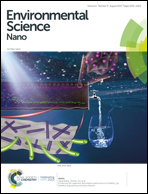One-step nanotopography construction by polyaniline polymerization for a superhydrophobic nanofibrous membrane towards direct contact membrane distillation†
Abstract
Constructing a rough membrane surface is one of the crucial factors to obtain a superhydrophobic membrane for application in membrane distillation (MD). Herein, we reported a facile approach to construct a rough membrane surface by one-step polymerization of aniline instead of traditional inorganic nanoparticles. A superhydrophobic polyvinylidene fluoride (PVDF) nanofibrous membrane (NFM) was obtained by combination of electrospinning, polyaniline coating and hydrophobization. The results showed that the modified PVDF NFM exhibited superhydrophobicity with a water contact angle (WCA) of 155° and a sliding angle of 7°. Moreover, the modified PVDF NFM with an open-cell pore structure presented a high water flux of over 28 L m−2 h−1 as well as robust stability for treating simulated seawater containing different organic or inorganic contaminants. Significantly, the simple one-step polymerization of aniline can be used as a universal tool to modify various substrates, which paved a new way using a polymer rather than inorganic nanoparticles for material roughness construction.



 Please wait while we load your content...
Please wait while we load your content...